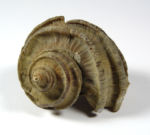Molluscs of the Tertiary

The Tertiary is the period of time between 65 and 2 million years ago. During this time the mussels and snails evolved especially intensively and became the dominant group of molluscs in the epicontinental seas. A further, lesser known group of molluscs became more important during the Tertiary, the “tusk shells” or scaphopods. Scaphopods have shells that look like the tusks of an elephant. In contrast mussels have two symmetrical valves and snails a single, coiled shell.
Although the species of mussels, snails and scaphopods were usually long-living they can be used as index-species particularly in the Tertiary. Index fossils are fossils that are characteristic for certain beds and are used to divide sedimentary rocks (stratigraphy). Among the Tertiary molluscs especially snails of fresh- and brackish water, as well as of well-oxygenated shallow water areas up to 200 m depth, are practical as index-fossils.
Molluscs are usually well-preservable since the calcareous shells are hard parts that can be preserved easily. The Geosciences Collection possesses fossils from several thousand molluscs of the Tertiary, the majority come from northern Germany.
The focal point of the Tertiary molluscs is mainly based on snails of the late Tertiary, also called the Neogene, between 2-24 million years ago. The Neogene material comes from localities all over the world, besides northern Germany specimens particularly come from Italy.

In the Miocene, about 5-23 million years ago, the ancient Baltic Sea covered northern Germany and adjacent countries and deposited mostly dark claystones. These layers are rich in molluscs and occur in northern Germany, the eastern Netherlands and southern Denmark close to the surface.

The collection contains material that was found south of Bremen, in the former Sunder claypit in Twistringen. The Twistringen collection is special since this claypit is the type locality of the Twistringen beds, the adjustment for this time span of the Tertiary, about 15 million years ago. The clastones successions portrays the environmental condition of the ancient northern European sea and is ranked as a “classical locality of palaeontology”. This is documented by an article in the first volume of the book “Klassische Fundstellen der Paläontologie” (claccical localities of palaeontology; Hagemeister 1988). One of the scientific papers by Janssen (1972) lists 190 species of snails, after closing the claypit in 1992 additionally 70 species have been discovered in the collections. Many species are recorded from Twistringen for the first time. From Miocene drilling cores in northern Germany, with a complete set of samples housed in the collection, Dr. E. Kuster-Wendenburg worked on the pyramidellids, a group of small-sized snails (Kuster-Wendenburg 1986)

Additional Miocene material cames from Gram in Denmark and an excavation under the supervision of Dr. E. Kuster-Wendenburg in Miste near Winterswijk in the Netherlands in 1987. The findings from Italy come from the Pliocene, mainly from the isle of Sicily and the wider area of Rome. These specimens were collected Förstner, Kemna and Klipstein. The collection houses Palaeogene fossils from the Eocene of France, especially mussels and snails from famous localities in the Paris Basin. These are namely Chauvey, Cuise, Damery, Grignon, Lizy and Chaumont, places that are “classical” from the modern point of view and that do not provide new material today. Among other people Klipstein already collected at some of these sites back in 1896 for the Bremen collection.
References
- Hagemeister, D. (1988). Die Tongrube Twistringen. – In Weidert, W.-K. (Ed.): Klassische Fundstellen der Paläontologie I: 162-169. Goldschneck, Korb.
- Janssen, A. W. (1972): Die Mollusken-Fauna der Twistringer Schichten (Miocän) von Norddeutschland. – Scripta Geologica 10: 1-95.
- Kuster-Wendenburg, E. (1986): Pyramidellidae (Gastropoda, Mollusca) aus dem Miozän des nordwestdeutschen Tertiärs. – Beiträge zur regionalen Geologie der Erde 18, 370-411; Berlin-Stuttgart.
- Menzel, H., George, P. & von Fick, C. C. (1984): Untersuchung des Profils der Tongrube Twistringen sw. Bremen (Mittelmiozän; Reinbek-Stufe). – Aufschluss 35: 137-150.
- Menzel, H. (1997): Die Tongrube der Ziegelei Sunder in Twistringen (Bez. Bremen). – Aufschluss 48: 16-20.
- — (1997): Die Ziegeleitongrube Sunder in Twistringen – Typuslokalität miozäner Fossilien. – Aufschluss 48: 154-160.



